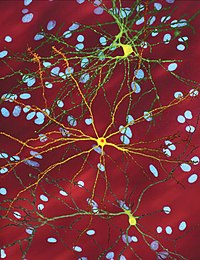
Photo from wikipedia
DNA damage by chemicals, radiation, or oxidative stress leads to a mutational spectrum, which is complex because it is determined in part by lesion structure, the DNA sequence context of… Click to show full abstract
DNA damage by chemicals, radiation, or oxidative stress leads to a mutational spectrum, which is complex because it is determined in part by lesion structure, the DNA sequence context of the lesion, lesion repair kinetics, and the type of cells in which the lesion is replicated. Accumulation of mutations may give rise to genetic diseases such as cancer and therefore understanding the process underlying mutagenesis is of immense importance to preserve human health. Chemical or physical agents that cause cancer often leave their mutational fingerprints, which can be used to back-calculate the molecular events that led to disease. To make a clear link between DNA lesion structure and the mutations a given lesion induces, the field of single-lesion mutagenesis was developed. In the last three decades this area of research has seen much growth in several directions, which we attempt to describe in this Perspective.
Journal Title: Chemical research in toxicology
Year Published: 2022
Link to full text (if available)
Share on Social Media: Sign Up to like & get
recommendations!